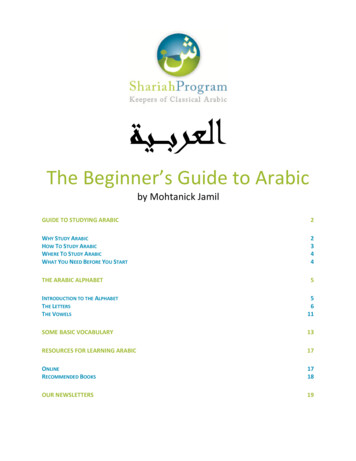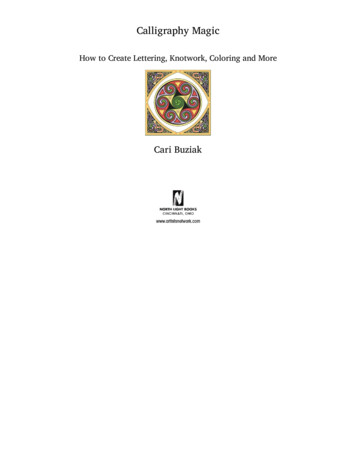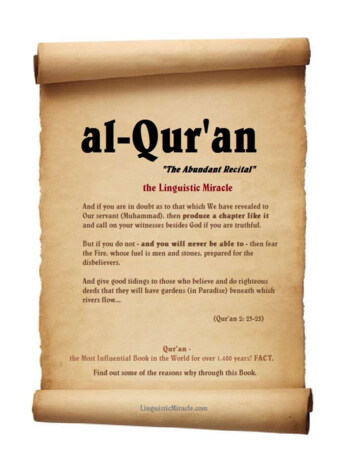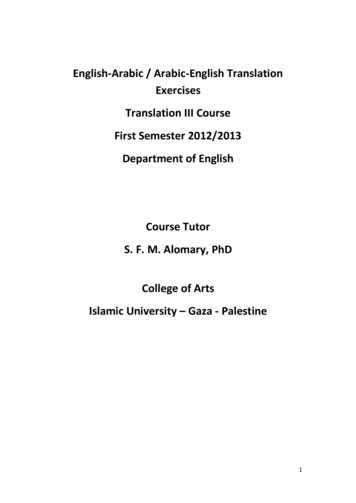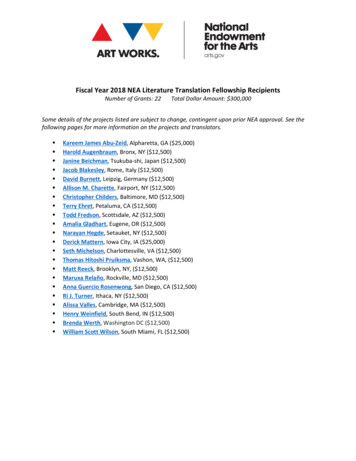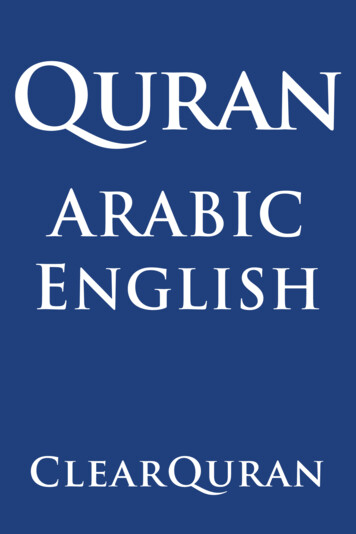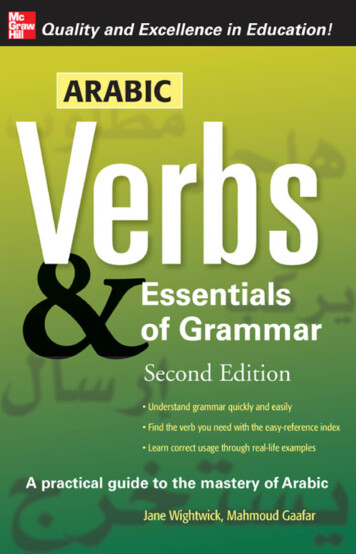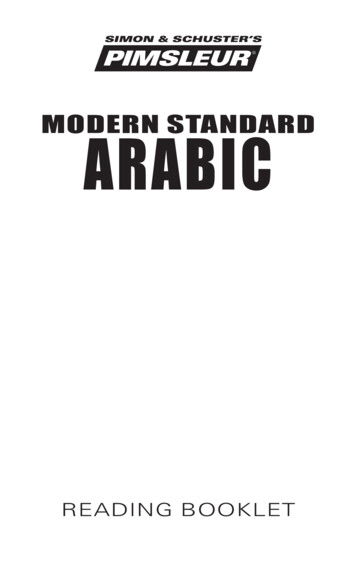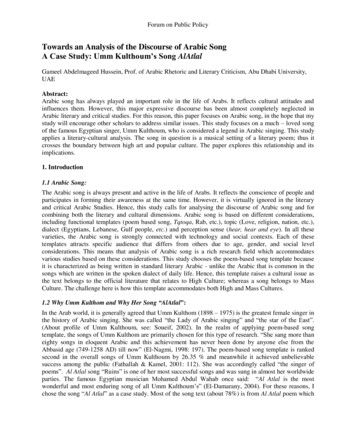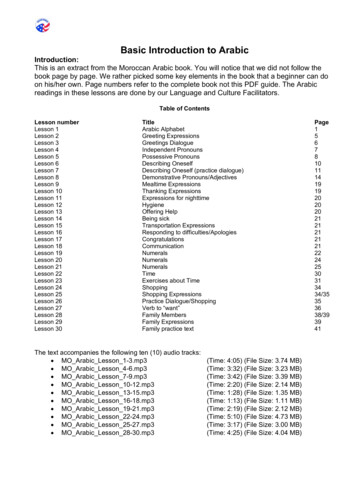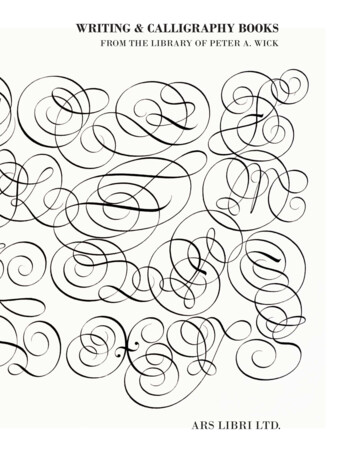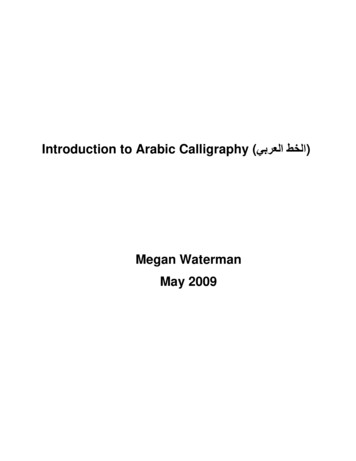
Transcription
Introduction to Arabic Calligraphy ( )الخط العربي Megan WatermanMay 2009
Introduction to Arabic Calligraphy ( )الخط العربي A component of a population's culture is the way in which its constituents expressthemselves. This expression can be orally, through written word, art, or music, or even inactions or gestures. It can be a combination of these artifacts, such as the case of Arabic or(used interchangeably) Islamic calligraphy. Many definitions of Arabic calligraphy exist; in myopinion, it is best stated as "the art of beautiful or elegant handwriting as exhibited by the correctformation of characters, the ordering of the various parts, and harmony of proportions”. [1] It hasalso been compared to music, as it "has its own rules of composition, rhythm, harmony, andcounterpoint -- elements that bring joy to the eye of the experienced beholder and to the lover ofbeauty and form". [2] Calligraphy is an important art form in the Middle East, and is ofteninterleaved with religious significance. Although this art form dates back centuries andcalligraphers often study techniques of the "masters", new styles constantly evolve, with sometouting a modern influence.Before we begin with the history of Arabic calligraphy, it first helps to have anunderstanding of Arabic. The next section briefly introduces the alphabet and its constructs.The Arabic AlphabetArabic is an ancient language belonging to the Semitic family of languages, whichincludes Hebrew and Aramaic. Semitic languages are often read from right to left across apage, and many letters in their alphabets are connected to the preceding and/or antecedingletter.In the case of Arabic, there are 28 letters. Of the 28, there are 3 long vowels (alef, waw,and yeh) and 25 consonants. There are three short vowels -- the fatha, the damma, and thekasra. The short vowels are denoted by diacritical markings, which are rarely used in everydaywriting. They often appear, though, in Qur'anic writings.The Arabic letters often take multiple forms, depending where the letter falls in the word.Most letters have an initial form (starting a word), middle form (middle of a word), ending form(ending a word), and stand-alone form. Many of the forms connect to the previous letter (if thereis one) and connect to the following letter (again, if there is one). However, there are six letterswhich are non-connectors, meaning that they do not connect to the letter that follows. These sixletters are alef, daal, thaal, zey, rey, and waw.Some Arabic letters are pronounced sharply, producing sounds that are difficult forWesterners to reproduce. The letters ayn, ghayn, and kheh in particular are different. TheArabic language is also known as the "daoud" language because Arabic is the only language in
the world that supports the sound made by the letter daoud.Arabic words have gender; an object may either be masculine or feminine. A specialcharacter called a tah marbuta is often associated with words of feminine form. The tah marbutais not a letter in the Arabic alphabet.There is also a glottal stop in Arabic called the hamza. Like the tah marbuta, the hamzais not considered one of the 28 letters in the alphabet, but occurs on vowels often.There are occasional "rules" in Arabic designed to keep its aesthetics intact. Forexample, the letter combination lam followed by an alef was not pleasing to the eye, and so aspecial character ( )ال was created for that letter combination.The Origins of Arabic CalligraphyAlthough Arabic writing existed before Mohammad received Allah’s words, it was thespread of Islam that served as the catalyst for Arabic calligraphy. During the Othman caliphate,these words were compiled into the Qur’an, or holy book of Islam. Followers wanted todemonstrate their devotion to Allah, and one way to do so is to exalt the verses and surahs ofthe Qur’an. The written word became very important in Islam, and so beautifying it and making itinto an art form served as a way to honor Allah. Thus, calligraphy began to boom during thecaliphate, and even the fourth caliph Ali was himself a calligrapher. Islam began to grow inpopularity and quickly spread throughout the Middle East, North Africa, and Spain, and with it,the increased need to read and write Arabic. [3]In many religions, paintings or sculpture of religious figures is commonplace. However,in Islam, images of the Prophet Mohammad were prohibited. It was felt that pictures of him wereidolatry, which is forbidden in Islam. This turned the focus again on the words of the religion,and further bolstered the rise of Arabic calligraphy.While Ali was alive, calligraphic schools began to develop and support the two mainbranches of Arabic calligraphy -- cursive script and straight-lined (angular) script. There werethree main centers -- in Mecca/Medina, Kufa/Basra, and Isfahan. Another Persian-based schoollater developed in India. [3]The Arabic language underwent many changes during the Umayyad and Abbasiddynasties. Short vowels (diacritical markings) were first introduced during the Umayyad rule.The dots that we see above and below modern Arabic letters were first used in conjunction withArabic forms during the Abbasid era. As the alphabet evolved, so did the calligraphy forms.Court papers began to be written in early cursive scripts. Abu Ali Muhammad Ibn Muqlah, acalligrapher and vizier (advisor) to three Abbasid caliphs, defined the six styles of calligraphy
(writing) and establishes the concept of proportion. Before this time, proportions of letters werenever considered. Ibn Muqlah designed a set of “rules” for Arabic calligraphy, including asuggestion that the height of the letter alef is the same size as the diameter of a circle in anArabic letter. He also set standards for the size of the dots on Arabicletters. These remarks led to more uniform styles of writing. [3]Calligraphy was also used in architecture, particularly inmosques, where it became a competition to see who could createthe most beautiful mosque, where beauty was measured in part bythe Arabic calligraphy that graced its walls. Arabic calligraphy onbuildings was popular in the 8th century, and both angular andcursive scripts were used in architecture. The image shown heredemonstrates both angular and cursive calligraphy on the Hassan IImosque in Casablanca, Morocco. [4][3]Arabic calligraphy flourished under many Arab dynasties. During the time of theMamluks, decorative art really took off. Everyday objects began sporting calligraphic designs,thereby increasing the need for experienced Arabic calligraphers. The art form itself was nowreaching a larger audience and thus experiencing a deeper appreciation. [3]During the Timurid dynasty in 14th century Persia, an emphasis was placed on writtenmaterials. As to be expected, calligraphy’s importance was emphasized during this time; in thefollowing reign of the Safavids, Ta’liq and Nasta’liq (two Persian scripts) were developed andused extensively. Coinciding with the Safavids, the Mughals in India built the world-renown TajMahal. This massive mausoleum displays cursive style Qur’anic sayings throughout the exteriorand interior of the building. [3] [5]The Ottoman dynasty (1444-1923) is where we see a huge resurgence in Arabiccalligraphy. During this time, many new styles develop including Tughra and Diwani. Jali Diwani,a highly intricate style of calligraphy that is still used today in royal circles, was born during theOttoman Empire. Indeed, during this time period, Arabic calligraphy was considered paramount.[3]Today, Arabic calligraphy continues to be a treasured art form in the Middle East. It hasevolved tremendously since the days of the Ottomans, but nevertheless, retains a mixture of itstraditional art form and the new modern approach.The Seven Scripts of Arabic CalligraphyThere are many different scripts of Arabic calligraphy, with various different styles
associated within a script. In this paper, I will introduce seven influential styles that impacted theMiddle East, Persia, and Northern Africa. The scripts vary by cursive/straight lines, the amountof slanting, and in letter creation.KuficOne of the earliest scripts is the Kufic or Kufi script, whichis thought to originate in the city of Hira. This angular script usesbold, short strokes for each letter. There is a squarishcomponent to each letter. In manuscripts, the letters oftenappeared as bold black characters while the diacritical markingswere a contrasting character, often red. Due to its thickness, itwas often used in stone carvings and in architecture. It was alsoused on various coins. For three hundred years, it was theprimary script used in copies of the Qur'an and is still in usetoday. There are various forms of Kufic script, including foliated,plaited, and Qarmatian ccan, so as onecould imagine, ed in NorthernAfrica, although thewriting style did contain some Persian and Turkish influence. Many of the final forms of theletters are lengthened in this script, and some letters, such as fa ( )ف , are written completelydifferently. [4][1][2]NaskhiNaskhi, which means “copying” was one of the earliest forms of cursive script, and is
creditedtoIbnMuqlah.Itwasusedextensively during the Abbasid dynasty fortwo main reasons. It was used to portclassical work; in other word, classicalliterature was rewritten into additional copiesusing the Naskhi script. Secondly, manyadministrative documents during the Abbasidreign were written in Naskhi.Naskhi isusually the first script that children are taught,and many computer fonts use a derivative ofNaskhi when printing Arabic letters. [4][1][2][6]ThuluthThuluth is one of the most commonforms of the cursive scripts. This methodoriginated in the 4th century, and is credited toKhalil Ibn-Ahmad al-Farahidi from Basra. Theword "thuluth" in Arabic means the fraction 1/3,as this form of calligraphy slants approximately1/3 of each letter. Thuluth is a large, clear scriptthat likely may be seen today in an everydaysetting (such as on money). The way that Ipersonally identify thuluth calligraphy is by theelongated vertical letters, such as alef ( )ا andlam ( )ل . In fact, this style is often used asornamentation on buildings and on titles and headings in books. It was also used in large printcopies of the Qur'an.There were three events during which major changes to thuluth calligraphy wereintroduced; these events were referred to as the “calligraphers’ revolutions”. The first eventoccurred in the 15th century. The second revolution during the reign of the Ottomans occurred inthe 17th century. The last upheaval, which resulted in the thuluth that we are familiar with today,happened at the end of the 19th century. [2][4][7][1]
Riq'aRiq'a is actually an everyday style of writing,often used in modern printings of books andmagazines. It is characterized by small, neat letteringin straight lines or curves. Riq’a is usually the secondscript that Arabic children learn, after Naskhi. Thestroke marks used in Riq’a tend to be very short andcrisp, as characterized by the size of the downturns inletters. Both Turkish and Arabic make use of the Riq'ascript. [4][8][2][1]DiwaniDiwani, and its variant JaliDiwani, were developed during theOttomanEmpire.Thisstyleisprobably the most decorative form ofArabic calligraphy. The letters arevery close together, making it hard toread, in some cases even by thosethat are fluent in Arabic. The style ishighly ornamental and decorative;pieces of Diwani calligraphy areoften adorned with minute details as to showcase a calligrapher’s skill level. Diwani calligraphyfor a long time was kept a secret to only a talented few, and was used as a royal calligraphyform. In my opinion, Diwani calligraphy is very elegant and requires much skill to produce suchstunning works of art; it is my favorite style of all those listed here. [2][4][9][1]Ta’liq/Nasta’liqThese two styles are Persian in nature and weredeveloped during the 14th and 15th centuries. This style isknown for its rounded forms and elongated letters. Ta’liq wasoften used in Persia for royal correspondence and was usedextensively during the Mughal Empire. Nasta’liq is a
combination of Naskhi and Ta’liq, and is considered the most ornamental of the Persian scripts.These scripts continued to be used today to write Persian (Farsi), Urdu, and Pashto.[2][10][4][1]Zoomorphic calligraphyAnimals are often used as themes in Arabiccalligraphy, and this practice is called zoomorphism.Zoomorphism, as a rule, is common in calligraphy ingeneral. Recall that images of Mohammed areforbidden,butimagesofother people or animals arenot. This makes zoomorphiccalligraphy a high desirableform of art.Zoomorphicpieces tend to be very ornate, and serve as hic calligraphy for the first time piqued myinterest because I appreciated how much planning andeffort was involved to make such stunning works of art.Two examples of zoomorphic calligraphy are displayed here, the bird [2] and the lion [11].The ToolsThe most important piece of equipmentfor the calligrapher is the pen. It is called acalamus or a qalam. It is usually created froma piece of reed, and it can be a long process tofinda reed thatis satisfactoryto thecalligrapher. The reed is fashioned into a stalk,which holds a nib. The nib is the point of thepen. The nib can be straight across or it couldcome to a point, depending on the style ofwriting. The nib could be wide (as in the caseof Kufic calligraphy) or it could be very fine (to create the intricate detail of the Diwali styles). A
calligrapher will often grow attached to a particular pen, and that pen may be passed downgeneration to generation in their family, or the pen may be buried with the calligrapher upon hisdeath.A calligrapher usually mixes their own inks. Although black and brown are the two mostpopular colors of inks, other colors may be used. For black ink, the calligrapher will use a veryfine dust of charcoal or soot mixed with gum arabic to create the ink. Arabic calligraphy is oftencreated on a cotton-based, rather than a papyrus-based, paper.Arabic calligraphers are chosen at an early age, and begin their training very young.They must learn the works of the masters, and their daily lessons are called “mufradat”. [12][2]Modern Arabic CalligraphyArabic calligraphy continues to be a valued art form. It is used everywhere, fromadvertising to computer fonts and graphics, to political items, such as the flags of Iraq (in kufic)and Saudi Arabia (in thuluth). Arabic calligraphy is an important facet of Middle Eastern culture,with a rich history steeped in tradition. I, for one, never tire of looking at the intricate details.Arabic calligraphy is often shown ingalleries around the world. In the nextsection, I will talk about an Arabic exhibit atthe Kennedy Center for Performing Arts inWashington, D.C. The artwork of HassanMassoudy, a famous contemporary calligrapher, was the centerpoint of the exhibition. [13][7]Arabesque -- an Arabic cultural exhibit at the Kennedy CenterAn exhibit on Arabic culture, entitled Arabesque, was held at the Kennedy Center forPerforming Arts from February 23 – March 15, 2009. There were many art forms at this event,including Arabic clothing and dress, , and Arabic calligraphy. The Desire to Take Wing eventshowcased two Arabic calligraphers – Hassan Massoudy ( المسعود ( البهبهاني )حسن and Farah Behbehani )فرح .Massoudy was born in 1944 in Iraq and studied with master calligraphers in Baghdad. In1969, he left an oppressive political climate for France. Living in such diverse cultures affordedhim a unique perspective; a perspective that is reflected in the art that he creates.In the Desire to Take Wing, Massoudy's work was displayed on four facets of a cube.Each side of the cube consisted of three rows and four columns to form twelve cells. Eleven of
the twelve cells displayed a calligraphy image. The remaining cell (in the first row, third column)played a video showing how the images were created. Each side of the cube wasmonochromatic, with the colors blue, teal, red, and black being the hues for each side. Twosides of the cube appear above.When viewed from a distance, the cube side makes a dramatic statement. Arabiccalligraphy is often seen as delicate and intricate, in muted colors. Massoudy's images areanything but. The letters are thick brushstrokes in bursts of color. His work is bold and modern,a juxtaposition of the French influence upon his Arabic upbringing.Yet, you have to look closely at the images not to miss the details. Close-up images oftwo panels appear below. These two images were portions of the blue side of the cube. In thefirst image, thepaint at the endsof the letters isheavy and dark.You can see theoutlineslettersofthethatappear behind aletter,indicatingthat the paintingwas done sectionby section (in thiscase,probably
letter by letter) over time, letting the previous section dry before painting another. In the secondimage, a detailed motif is displayed in the bottom center of the image. The intricate black writingat the bottom of the image, in various sizes, must also be noted to obtain the full effect of thework.Behbehani was born in 1981 and studied with master calligraphers in London. She has receivedmany citations and merits for her work, and is considered a rising star in the Arabic calligraphyworld. Behbehani displayed ten images in the gallery, drawn in the Jali Diwali style ofcalligraphy. The theme was Conference of the Birds, derived from a 12th century Sufi poem,and each image is based upon a bird.The theme of the first image is a hawk, which symbolizes the sun and the eye of thejourney1. The circular form is a common shape in Arabic calligraphy. Note the detail and fragilityof the Jali Diwali style; it's almost like looking at a piece of fine lace as opposed to a series ofletters!Accompanying each image were pencil drawings which show the placement of lettersand diacritical markings. I included one of the pencil drawings for the hawk below. As one canimagine, there is a tremendous amount of preparation involved to produce a single piece ofArabic calligraphy, and the pencil drawings serve as guides.The theme of the second image is the finch. The main black image shows a fragmentedversion of the finch. Because the finch is known as a weak bird, the bird is encircled by the bluetext ( )ضعف , which means weak in Arabic. The word for weak, which appears three times in the1Many of the interpretations and meanings behind these drawings accompanied each work of art at the KennedyCenter for Performing Arts, March 15, 2009.
drawing, is written in three differing forms of calligraphy.The theme of the third image is "Seven Valleys of the Way". This depicts seven birds,with each bird one of seven different words -- confidence, peace, freedom, hope, faith, love, andhappiness. The letters are in black, while the diacritical markings appear in a teal ink. The largeblack image in the middle is also a bird.The fourth image was the Simorgh. Part of the “Conference of the Birds” poem mentionsthe Simorgh, saying:“It was in China, late one moonless night,The Simorgh first appeared to human sight –He let a feather float down through the air,And rumours of its fame spread everywhere;” [14]The letters qaf ( )ق and alef ( )ا are used in this piece to represent Mount Qaf, where the birdmeets the king. In typical Diwani style, the letters qaf and alef are very close together, but I hadlittle trouble distinguishing these letters when I first saw this piece. The intertwining of the lettersmade me think of a flame; there is afamous Arabic calligraphy piece thathas the word Allah appears as aflame, and this artwork reminded meof that image.The fifth image was the Duck.I had a lot of trouble understandingthis piece; I didn’t see a resemblanceto a duck, and I wasn’t familiar with
the story that the image is based upon (a story about a duck being “pure”). The description didmention a duck’s fascination with water, and in my interpretation, the image does look likeflowing water, perhaps a waterfall or a river.According to myth, the Homa is said to have a role in choosing the next Ottoman sultan.There is a very nice juxtaposition in this image, as the homa (depicting as the bird in black) hasas its shadow the name of the sultan (in gold lettering). The name, or signature of the sultan, isreferred to as the Tughra. This image seems to indicate that this bird is above, looking downupon the sultan from its lofty flight.The word for partridge ishajalahletters,( )الحجل . ح and ج ,Thefirsttwoare depict thepartridge in this drawing. Note thatthe dot for the letter jeem ( )ج isdrawn in red ink; in fact, red, blue,and green inks adorn the secondpart of the image. According to thestory of the partridge, these birdshoard precious jewels and gems,which are depicted by the rich colors of ink in the drawing.Thenextimagewas,without question, my favorite piecein the whole exhibit. It was adrawing of a peacock. It really wasexquisite; the detail on the bird,especially the tail, was incredible.The tail was supposed to signifyparadise and heaven; it was notedthat green is considered the colorof heaven by the Sufis. I also tooka picture of the pencil drawing for the peacock, since it clearly took a lot of planning and effort tocreate this piece.The ninth piece signified a parrot. It was the only piece in Behbehani’s collection thatwas symmetric; every letter appeared twice in the image, with the exception of the red tah
marbuta in themiddle.The lastpicture was forthehoopoe.According to theSufi poem, thehoopoe was theleader of all thebirds.Itwasfitting, therefore, that the words chosen for the hoopoe was the Bismillah ( اهلل – )بسم In the nameof God, the Merciful, the Compassionate. It is undoubtedly one of the most famous lines fromthe Qur’an, and routinely appears in Arabic calligraphy.I was impressed with the calligraphy exhibit at the Kennedy Center. Although I hadexpected a larger display of calligraphy (it was held in the Nations Gallery, and so I hadassumed that there would be rows of various pieces), I felt that the pieces were well chosen andhad a common theme. It was a little thrilling to see the artwork of Massoudy up close; his nameappears frequently on the Internet as a famous calligrapher of today, and his works appear atleast twice in one of my main sources – the Arabic Script book by Khan.References[1] http://www.arabiccalligraphy.com, April 6, 2009.[2] Khan, Gabriel Mandel, Arabic Script. Abbeville Press Publisher, New York: 2001.[3] http://www.islamicart.com/main/calligraphy, April 6, 2009.[4] Khatibi, Abdelkebir and Sijelmassi, Mohammed, The Splendor of Islamic Calligraphy.Thames & Hudson, London: 1976.[5] http://en.wikipedia.org/wiki/Taj Mahal, May 8, 2009.[6] http://en.wikipedia.org/wiki/Naskh (script), May 12, 2009.[7] http://en.wikipedia.org/wiki/Thuluth, May 12, 2009.[8] http://en.wikipedia.org/wiki/Ruq%27ah, April 14, 2009.[9] http://en.wikipedia.org/wiki/Diwani, May 8, 2009.[10] http://en.wikipedia.org/wiki/Ta%27liq (script), May 12, 2009.[11] t/rooms/room25.htm#calligraphylion, April26, 2009.
[12] http://commons.wikimedia.org/wiki/File:Learning Arabic calligraphy.jpg, April 26, 2009.[13] http://en.wikipedia.org/wiki/Kufic, May 17, 2009.[14] http://en.wikipedia.org/wiki/The Conference of the Birds, May 11, 2009.
Arabic is an ancient language belonging to the Semitic family of languages, which includes Hebrew and Aramaic. Semitic languages are often read from right to left across a . ornamentation on buildings and on titles and headings in books
